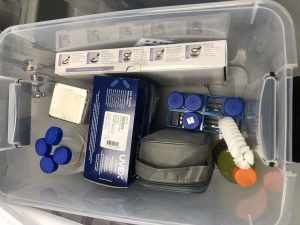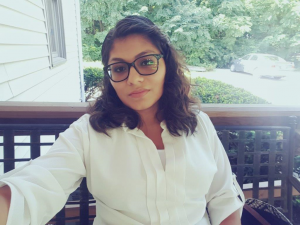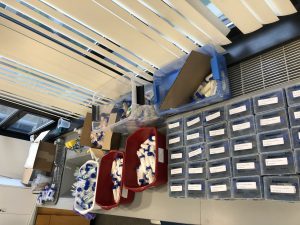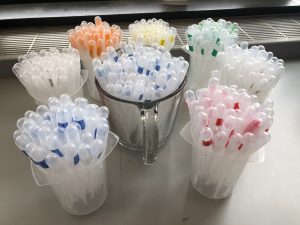 In the weeks leading up to the start of fall semester, tabletops usually reserved for in-class science experiments were largely hidden underneath several dozen of plastic containers.
In the weeks leading up to the start of fall semester, tabletops usually reserved for in-class science experiments were largely hidden underneath several dozen of plastic containers.
Each container held small vials of meticulously measured ingredients, carefully cleaned lab equipment and any extra items Samantha Dean envisioned a student might need to run a successful lab course out of their own home.
The interruption that the COVID-19 pandemic brought to spring semester had inspired Dean, the science lab coordinator for UB’s Division of Science, Information Arts and Technologies, to brainstorm the best way for students take lab courses in a solely online environment.
She considered two options: the obvious way, which involved a pre-built, online-based lab program that students would do on their computer, and the hard way, a homemade solution that would require a lot of planning and time.
“We felt that an entirely online system just wasn’t doing a service to our students,” Dean said.
So she got to work on the alternative.
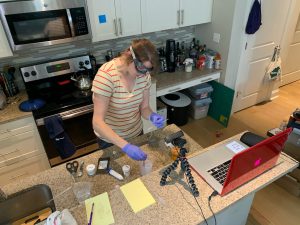
science lab coordinator Sam Dean recording videos of herself conducting experiments to help guide students
Dean ended up building about 120 kits to cover three fall classes that required labs—ENVS 221 with Stanley Kemp, BIO 111 with Wolf Pecher and BIO 121 with Elka Porter. Each class would require slightly different kits, leaving Dean to consider what the faculty wanted to teach and how could she downsize a semester’s worth of experiments into one container. Safety and delivery had to be considered as well.
“We’re not accepting that we’re going to give our students an inferior product,” said Kemp, an associate professor. “We’re still fully in control of it. We’re trying to give them the same experience as in the classroom, face to face.”
Dean taught a summer class, BIOL 121, that would become an experiment in itself.
For that class, she built kits that included Gatorade for a DNA experiment; seeds, a lightbulb (either red, green or white) and a pot for a photosynthesis lesson; and a variety of small items for various tests, including a vial of iodine, glucose tablets, Lactaid pills and milk powder.
Students worked with Dean to arrange a curbside pickup day to get their kit. Students had to agree to return the kits after the class ended and also to keep the container in a safe place away from children or pets.
Dean wanted all the ingredients to be items the students might already have at home or could easily buy at the store. That way, they could feel comfortable with the materials they were working with or easily find replacements if an experiment went awry.
Having common ingredients also helped punctuate the point that science is more a part of their lives than the students may have previously realized.
That hit home for Kelly Coleman, one of Dean’s summer students.
“Pretty much all of the labs that we did were useful for everyday life and health. I can’t tell you how many times I was in a conversation with my boyfriend and I was like, ‘Well, I learned in my bio class this week…’” she said.
Beyond preparing the kits, Dean also recorded videos of herself doing each experiment so students could have a better understanding of the process.
Donna Cureton, a business administration student in the summer class, appreciated the step-by-step video guide.
“I was able to learn and comprehend at my own pace without trying to keep pace with the class,” she said. “I was able to rewind the video lectures and take better notes than I have in an in-class setting.”
The videos, in part, aimed to help make up for one aspect of the on-campus lab that students lost—the lab partner. At home, students were largely on their own, unless a curious family member was willing to help.
Blanca Ventura Diaz, also a business administration student, had some help from her husband who wanted to see how her experiments turned out, particularly one that involved growing a plant. Her plant even went on a summer vacation to Florida so they didn’t miss a measurement.
This was the first lab course that Diaz had taken and she was already nervous before realizing it would be fully online. A friend from another college had told Diaz that her lab class had involved simulated labs on the computer. Diaz hoped that wouldn’t be the case at UB.
“When you do a digital one, you don’t really have the desire to see how it turns out. It’s just a computer; it’s going to tell me if it’s wrong. There isn’t any life to it. I’m more visual. I like hands-on; the experience is right in front of you,” she said.
Others in her class felt the same way.
“This is better than sitting for an online, click-through lab situation because I know they exist and that’s not as fun,” Coleman said. “There’s a fun aspect to mixing solutions. It feels like a kid with a chemistry set.”
That reaction was what Dean was hoping for.
“We definitely get students who come in that are kind of gun shy. ‘I had a terrible experience with science in high school and I hated it,’ and ‘I don’t want to be here,’ and if we can make that fun for them, and possibly something that their whole family can be involved in, then that’s absolutely what we’re going for here—to make science engaging, to make science fun, to make science something that is not just for people in white coats in an ivory tower. It’s something everyone and anyone can do,” she said.
Despite the painstaking work behind creating the kits, Dean thinks it was the right decision, not only for the students who benefit from hands-on lessons in a likely otherwise online dominated semester, but also because of the impact it can have on how the division runs future lab courses, on campus or online.
“In the situation that we have now, which is unprecedented, unexpected, I think it’s a situation that absolutely breeds ingenuity,” she said.

